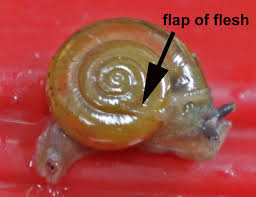
The Horntail Snail, Macrochlamys indica, was detected in Miami-Dade County in August 2020 and sent to the University of Florida for identification. This identification was confirmed by USDA and Florida Department of Agriculture (FDACS), Division of Plant Industry. An eradication program is now underway to stop the spread of this federally regulated pest. This is the first occurrence of this pest in the United States and could become a significant pest for Florida’s agricultural industry if not stopped. The horntail snail is a major pest in India, feeding on lettuce, beans, yams, and chrysanthemums. It is most active at night and after rainfall events. The snail will also burrow in the ground in dry, hot weather or cool, damp locations, so it might be found under plant containers or in moist soil.
To date, there are seven cores within Miami-Dade County that represent 34 positive properties. Cores extend out 200 yards from the positive detection. There have been 1,200 snails collected, which includes 200 that were already dead. The southernmost positive property is in Florida City, where more than 400 parcels have been surveyed with only one positive location. Three nurseries within Miami-Dade County have had positive surveys with snails present on the property. Those nurseries must enter a 30-day hold order to prevent spread of the snail. There have been 200 cumulative treatments with snail baits conducted to date according to Holly Hughes, Public Information Specialist with FDACS.
Identification

The horntail snail has a delicate, amber-colored shell, the size of a dime, and a fleshy, pointed protrusion, called a caudal horn at the tip of its tail. This caudal horn is only found in one other species, Ovachlamys fulgens. Additionally, there is a flap of flesh that extends backwards onto or around the shell, when relaxed and alive. This differentiates it from other terrestrial snails in the state.
Concerns
The horntail snail has the potential to be a host of rat lung worm, which can cause meningitis in humans. Gloves should be worn when handling the snail. If residents or landscapers suspect a positive detection of this snail, contact Monroe County Extension Service at (305) 292-4501 or FDACS Division of Plant Industry at dpihelpline@fdacs.gov to submit photos of the snail.
For more information visit the Florida Department of Agriculture pest alert page: https://www.fdacs.gov/Divisions-Offices/Plant-Industry/Plant-Industry-Publications/Pest-Alerts
 0
0
